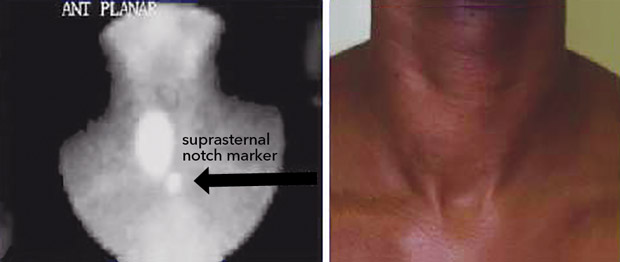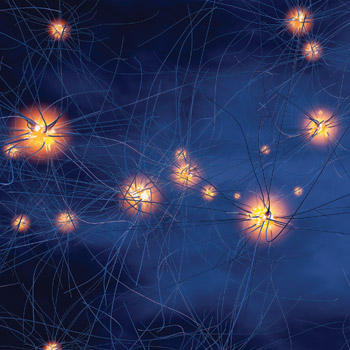MKSAP Quiz: Follow-up evaluation for hyperthyroidism
A 55-year-old woman is seen during a follow-up evaluation for hyperthyroidism that was diagnosed 1 week ago. Thyroid examination revealed a palpable right thyroid nodule.

Thyroid-stimulating hormone (TSH) was less than 0.01 µU/mL (0.01 mU/L), free thyroxine (T4) and total triiodothyronine (T3) were 2.1 ng/dL (27.1 pmol/L) and 210 ng/dL (3.2 nmol/L), respectively. Atenolol was prescribed, and thyroid scintigraphy with determination of radioactive iodine uptake was ordered.
On physical examination, vital signs are normal. The neck and corresponding thyroid technetium-99 scan is shown.
Uptake at 24 hours is 30% (normal 14% to 30%).
Which of the following is the most appropriate management?
A. Fine-needle aspiration biopsy of the thyroid nodule
B. Increase atenolol dosage
C. Methimazole
D. Radioactive iodine (131I) therapy
Answer and critique
The correct answer is D. Radioactive iodine (131I) therapy. This item is Question 61 in MKSAP 18's Endocrinology and Metabolism section.
The most appropriate management is radioactive iodine (131I) therapy. The patient's examination findings and thyroid scintigraphy results are consistent with a diagnosis of toxic adenoma. Toxic adenoma and multinodular goiter are the second most common cause of hyperthyroidism overall and are most frequently seen in older adults. These autonomously functioning nodules synthesize and secrete thyroid hormones independent of thyroid-stimulating hormone (TSH) stimulation as a result of activating mutations of the TSH receptor or Gsα. They are usually large and can be easily palpated on examination. First-line treatment options include radioactive iodine therapy or surgery. Radioactive iodine is the most commonly used first-line treatment. The radioisotope 131I emits both gamma and beta radiation. Gamma radiation can be detected by the camera to determine radioactive iodine uptake and create an image of the thyroid gland during thyroid scintigraphy, whereas beta radiation yields the therapeutic effect by triggering thyroid follicular cell death. If a patient has a particularly large goiter with compressive symptoms or if there is concern for malignancy, surgery is recommended as first-line therapy.
Autonomous nodules are associated with a very low risk of malignancy (<1%), and fine-needle aspiration biopsy is not indicated. If biopsy is performed, it frequently yields indeterminate cytology results, such as suspicion for follicular neoplasm, and generates inappropriate concern and unnecessary recommendations for follow-up examinations and biopsies.
Increasing the atenolol dosage and prescribing methimazole are also not the best management options. While β-blockers ameliorate adrenergic symptoms, they do not address the underlying cause. This patient has a normal heart rate and blood pressure on her current dose of atenolol, so increasing this further is not indicated.
Antithyroid drugs (methimazole) are not first line for managing hyperthyroidism because spontaneous remission does not occur and treatment would have to be continued indefinitely.
Key Point
- First-line therapy for toxic adenoma is radioactive iodine (131I) therapy or surgery.



